An appreciation of normativity
Normative - related to notions of commitment, entitlement, and responsibility
TTT 2023 - Kris Brown

(press s for speaker notes)
2/6/24
Examples of appreciating normativity
$$
$$
- Commodity fetishism (Marx)
“a form of reification, commodity fetishism presents economic value as inherent to the commodities, and not as arising from the workforce, from the human relations that produced the commodity, the goods and the services.”

How does it come about that this arrow ⟼ points? Doesn’t it seem to carry in it something besides itself? “No, not the dead line on paper; only the psychical thing, the meaning, can do that” – That is both true and false. The arrow points only in the application that a living being makes of it. This pointing is not a hocus-pocus which can be performed only by the soul… “When we mean something, it’s like going up to someone, it’s not having a dead picture (of any kind).” – Philosophical Investigations
Danger: relativism, skepticism, pseudoscience, amorality
Map metaphor better appreciates normativity
Danger: relativism, skepticism, pseudoscience, amorality
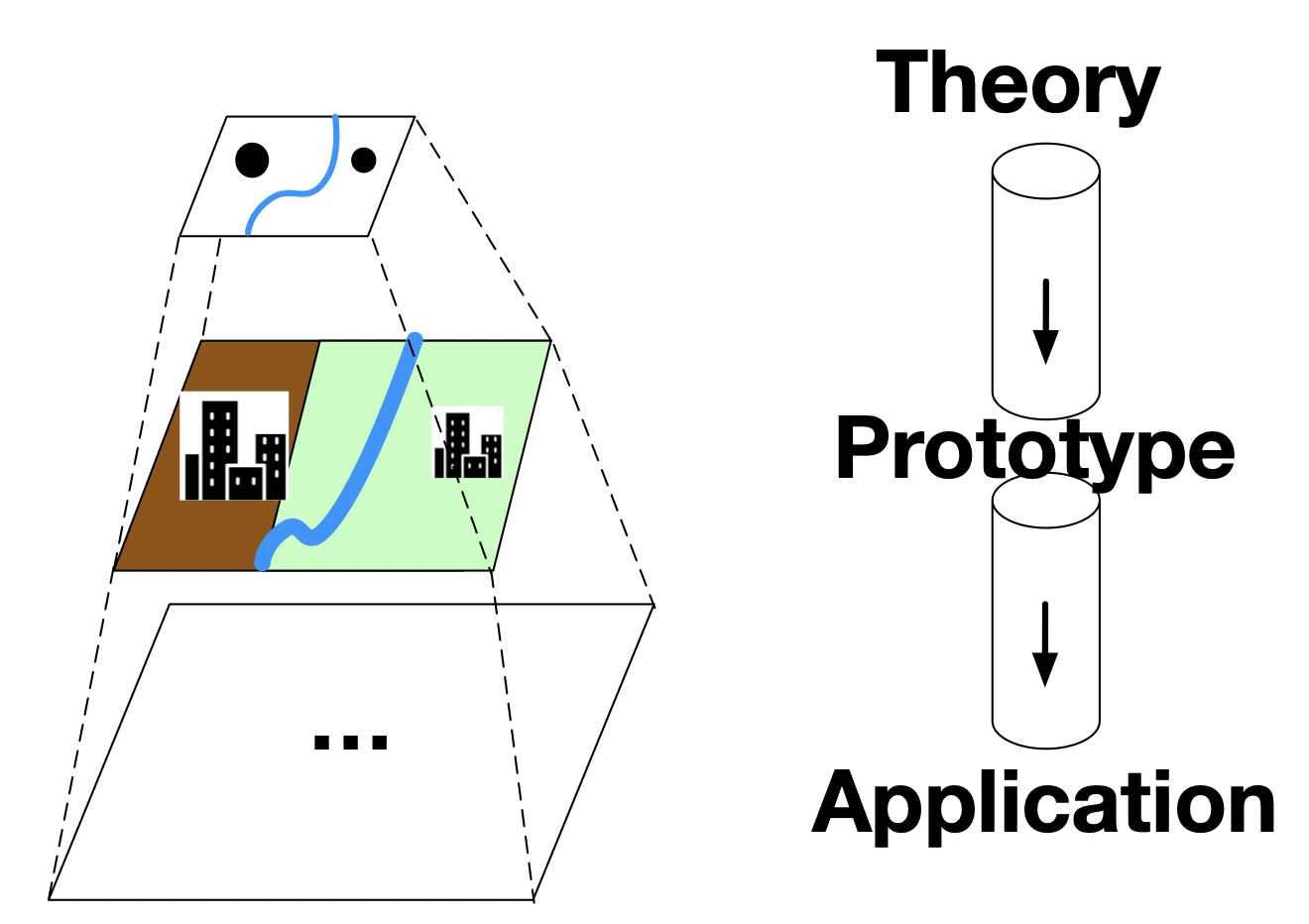
To some extent, our understanding of the world depends on us
- Our interests (which aspects the map foregrounds)
- Our limitations (what we are capable of recording)
Historical context of map metaphor
Danger: relativism, skepticism, pseudoscience, amorality
Representation is made explicit by Descartes in mathematics and philosophy.
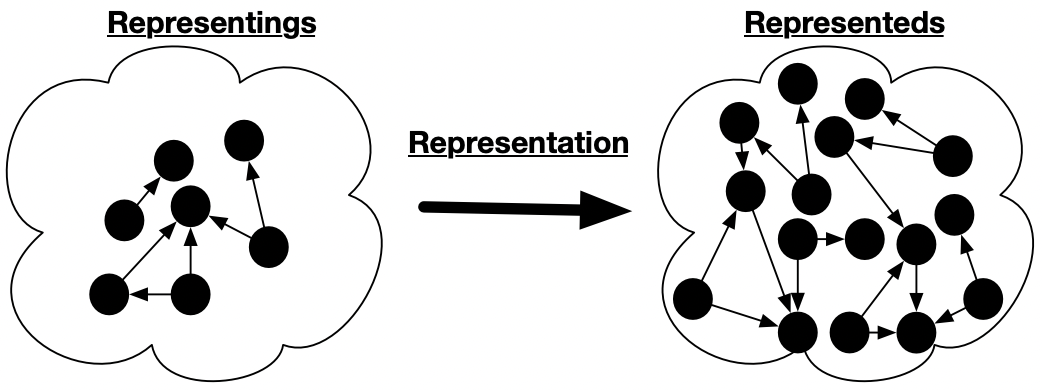
Good consequence: attitude towards norms becoes more critical.
Bad consequence: world divided into two fundamental types of things
| Representings | Representeds |
|---|---|
| Perception | Reality |
| Social construction | Nature |
| Values / norms | Facts |
| Propositional beliefs | Things |
- Mind/body problem: How is the mind affected by real stuff / how can the mind cause real events?
- Norm/fact problem: How can we know about norm stuff? (in the way we know about mass) Where in the world of natural science do we find these things?
Distinction: theoretical and practical reason 1
Danger: relativism, skepticism, pseudoscience, amorality
| Theoretical | Practical | |
|---|---|---|
| Motivating question | What are we to believe? | What are we to do? |
| Goal | The True (correct beliefs) | The Good (desirable actions) |
| Reality | … is found | … is made |
| Direction of fit | World → Mind | Mind → World |
Enlightenment lesson: practical norms come from us (not God / nature).
Radical idea
Moving beyond the map metaphor requires recognizing theoretical norms also come from us.
This seems radical because there is an important sense in which certain theoretical norms (“if I drop this marker, it will fall”) are dictated by the world, that certain propositions have truth which is found, not made.
Ambiguity in legal interpretations
Danger: relativism, skepticism, pseudoscience, amorality
“Employers cannot discriminate on the basis of sex” – Equal Pay Act (1963)

Ambiguity is resolved by authority of judge. But where does this authority come from?
- We want reasons why the meaning of the law dictates the verdict.
- No mechanical way to prove the verdict follows from the law, so is the judge’s authority simply the violent power of the state?
Legal formalism vs legal realism
Danger: relativism, skepticism, pseudoscience, amorality
| Legal Formalism | Legal Realism | |
|---|---|---|
| What is the goal of legal theory? | Determine correct procedures for determining the relevant facts and applicability of statutes. This is a normative ideal; there is a right and wrong way to do it. | Describe what judges really do, which is contingent on their cultural upbringing, personal biases and beliefs, mood, etc. |
| Does the law settle the verdict of the case? | Yes, law is determinate (if the judge is doing their job correctly). | No, law is indeterminate. |
| The correct verdict | … is found. | … is made. |
| Problem arising from norm-fact distinction | How does the judge get in contact with the meaning of the law? | Skepticism about norms being real, as they don’t fit into the natural world. |
Common law: precedent
Danger: relativism, skepticism, pseudoscience, amorality
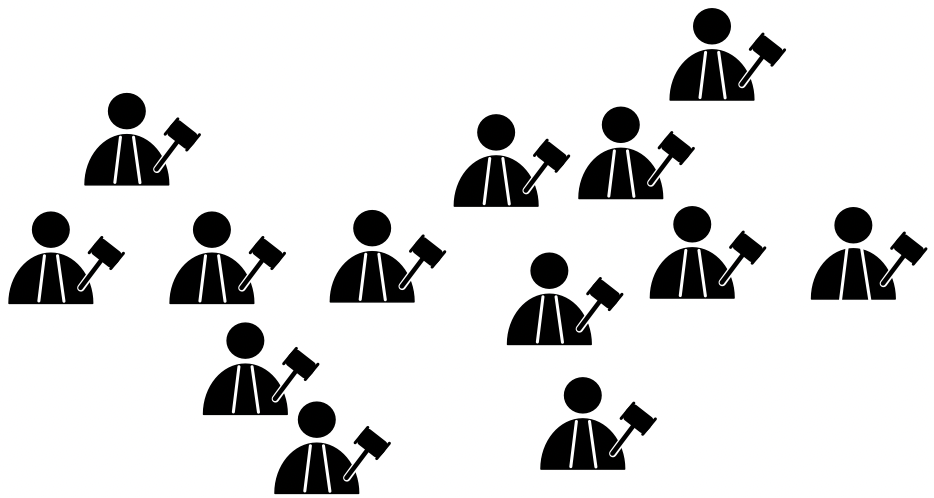
Common law: precedent
Danger: relativism, skepticism, pseudoscience, amorality
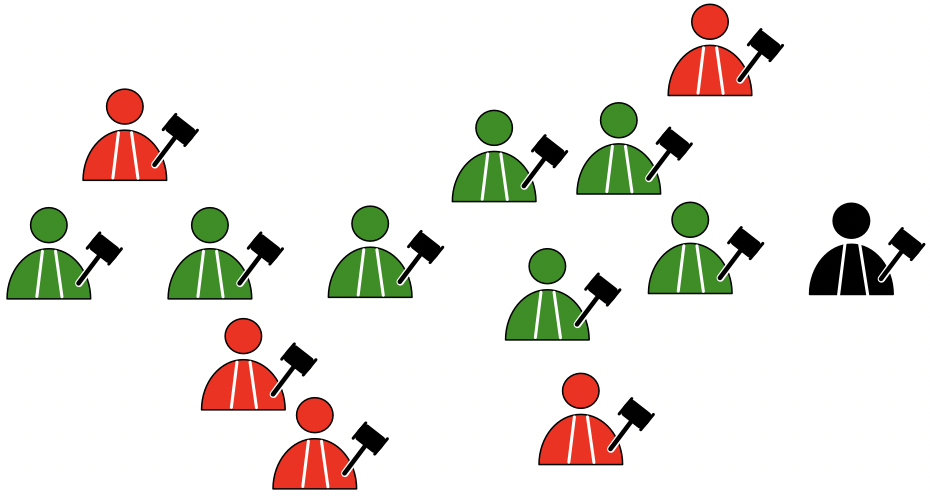
Common law: operad of precedent
Danger: relativism, skepticism, pseudoscience, amorality
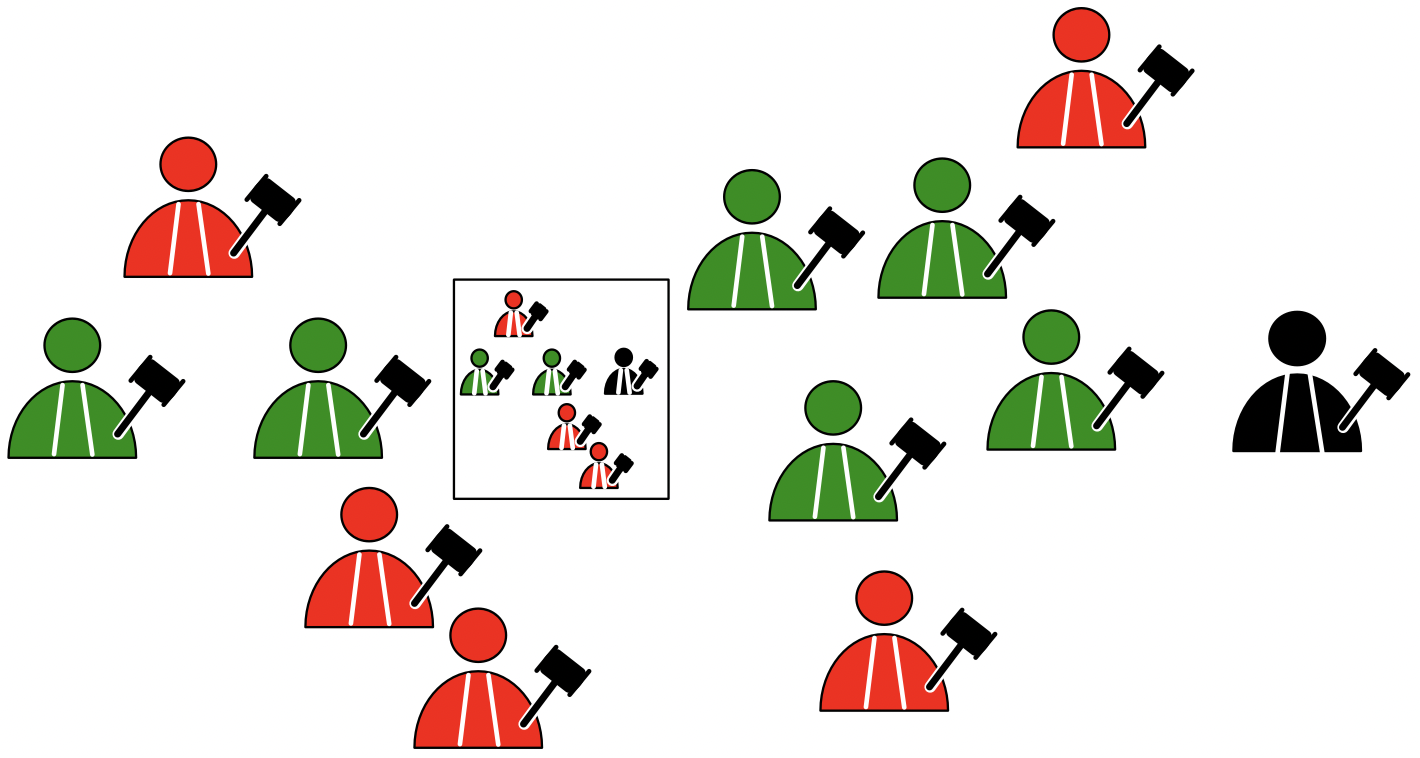
Common law metaphor for conceptual content
Danger: relativism, skepticism, pseudoscience, amorality
Rational reconstruction is a kind of making that is also a finding.
- Finding (theoretical reason, looking retrospectively): verdict cannot be framed as a choice; we tell a story where we find out which concept applications are precedential according to our understanding of the conceptual content.
- Making (practical reason, looking prospectively): we are making an action by interpreting the meaning in a particular way; this affects our peers (who have a responsibility to incorporate our usage into their verdict.)
Rational reconstructions give contingency the form of necessity.
- Necessity: Whether past judges explicitly realized it or not, their decisions were the result of (objective) norms which have always existed. (“discrimination”, “tort”, “malice” have actual/objective meanings, they are not just words)
- Contingency: maybe what I ate for lunch did in fact influence my reconstruction. That’s for future generations to decide.
Common law metaphor for conceptual content
Danger: relativism, skepticism, pseudoscience, amorality
Normative structure:
obedience / subordination

Normative structure: mutual recognition
authority only with correlative responsibility

Radical idea
This is no metaphor in describing the semantic content of legal terms. But we can use this metaphor to understand semantics generally, not just legal terms. One may be inclined to do this if one realizes:
- The tradition we’ve been born into takes the map metaphor for granted.
- The negative features of map metaphor are addressed by the common law metaphor.
- The virtues of the map metaphor are recoverable as a special case of the common law metaphor.
Outline
Danger: relativism, skepticism, pseudoscience, amorality
- Uncontroversial examples of normativity
- Commodity fetishism, pointing of an arrow
- Pipeline vs map metaphor
- Problematic separation of norm and fact of the map metaphor
- Common law metaphor
- More controversial examples of normativity
- Definitions in mathematics
- The referents of ordinary speech and science
- The “success of science”
- The propositional contents of our thoughts
- The representational relation
Mathematics
Danger: relativism, skepticism, pseudoscience, amorality
Obedience / subordination model
Mathematicians work with definitions. They make statements which, if true, are true by virtue of the meanings of terms they use. This truth is independent of the attitudes of any human beings (or even of our understanding of the natural world).
- If someone tells you “I can prove this circle intersects with this line at three points,” then you reply “Then you must mean something different by circle, intersect, line, point, or prove.”
Mutual recognition model
- The community has a notion of a Foo.
- Someone proposes a “symmetric Foo” (or a “2-Foo”, or a “monoidal Foo”).
- There is a sense in which they can define these to be whatever they want, but that is a very weak sense.
- A more robust sense is modeled off of common law example:
- One justifies their claim to the concept “monoidal Foo” by appealing to previous uses of “symmetric” and “Foo”.
- If the community vibes with this recollection, then it gets adopted.
- Sometimes even an honest effort (e.g. to define higher-order categories) is not judged to be precedential.
David, who agonizes about finding “the right name” for a new concept he discovers / makes, is doing math this way.
Referents in ordinary speech and in science
Danger: relativism, skepticism, pseudoscience, amorality
Paradigm of reference:
naming

Paradigm of reference:
inferential role

When all is going smoothly, a name suffices to determine meaning.
- Different people with incompatible claims about the same name are either in actual conflict or they are referring to different things.
- To the extent that we massively agree in our interpretations of a concept and cannot envision interpretation ever changing, the map metaphor is appropriate.
- This is the extent to which the chair in the room exists and is made sense of via the map metaphor.
But we also recognize often there are multiple parties vie for authority over a name. Or recognizing that someone in another context (cultural, historical) was talking about the same thing using a different name.
Referents in ordinary speech and in science
Danger: relativism, skepticism, pseudoscience, amorality
Jones says “The witch who lives in the house at the end of the street really scares me.” We, not believing in the myth of witches, can have a couple of reactions to this:
- Jones referred to the woman who lives at the end of the street, and the fact he implicitly described her as a witch just betrays some false auxiliary belief he has about witches.
- Jones failed to refer to the woman at the end of the street because she isn’t a witch (since no witches exist).
False dichotomy induced by the map metaphor
Likewise for phlogiston:
| Phlogiston does not exist | Phlogiston refers to oxygen |
|---|---|
| Phlogiston was made (unlike oxygen) | Phlogiston was found (like oxygen) |
| “Phlogiston theory led to experiments that ultimately concluded with the discovery of oxygen.” | “Early experiments about oxygen concluded it had negative mass.” |
Distinguishing science
Danger: relativism, skepticism, pseudoscience, amorality
Naive account of success of science
Across time, some people were “doing science” and other people were not.
People who did science were able to get what they want easier, all else equal.
Actions / practices are, by their intrinsic nature, either “scientific” or not.
We know this through common sense: you know it when you see it.
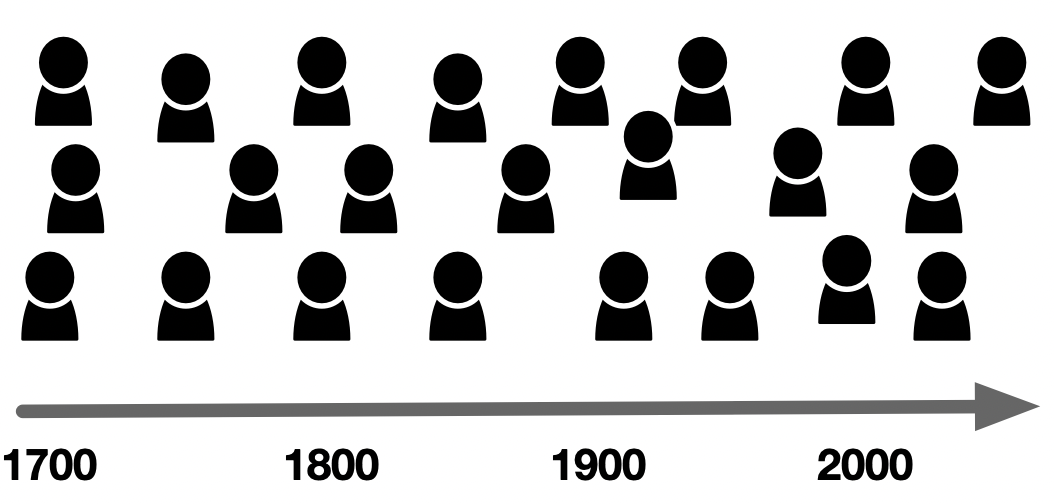
Distinguishing science
Danger: relativism, skepticism, pseudoscience, amorality
Naive account of success of science
Across time, some people were “doing science” and other people were not.
People who did science were able to get what they want easier, all else equal.
Actions / practices are, by their intrinsic nature, either “scientific” or not.
We know this through common sense: you know it when you see it.
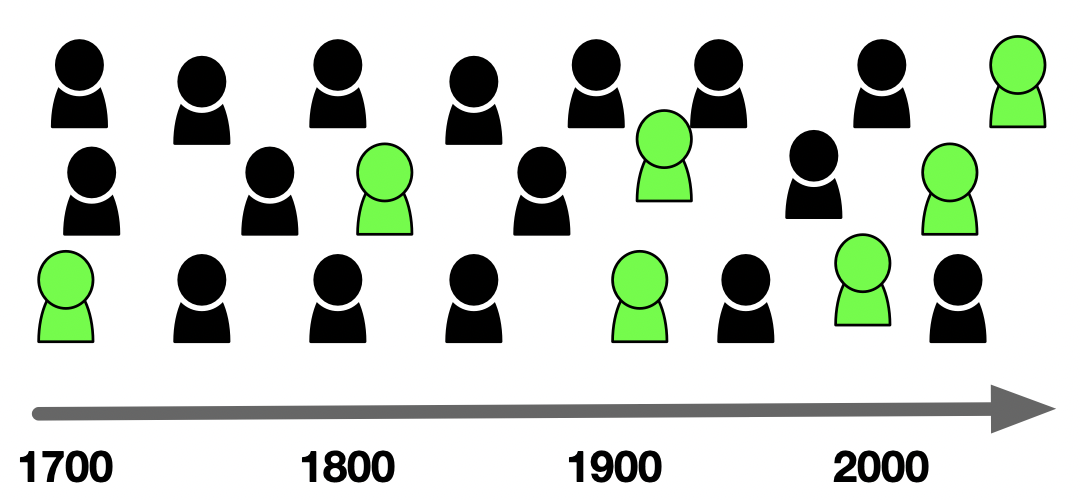
Distinguishing science
Danger: relativism, skepticism, pseudoscience, amorality
Dissatisfaction with ‘science’ as primitive
We can ask the metaphysical question “what makes an action / practice truly scientific?”. We look for a definition.
- The definition adjudicates all past and future uses of the concept scientific.
- The definition reduces terms in a problematic vocabulary to an unproblematic vocabulary
- People disagree on what they consider unproblematic (e.g. natural science, ordinary language, FOL, ZFC)
- One has to take some vocabulary as unproblematic to get off the ground.
The normative structure of a definition like this is the authority/subjugation model.
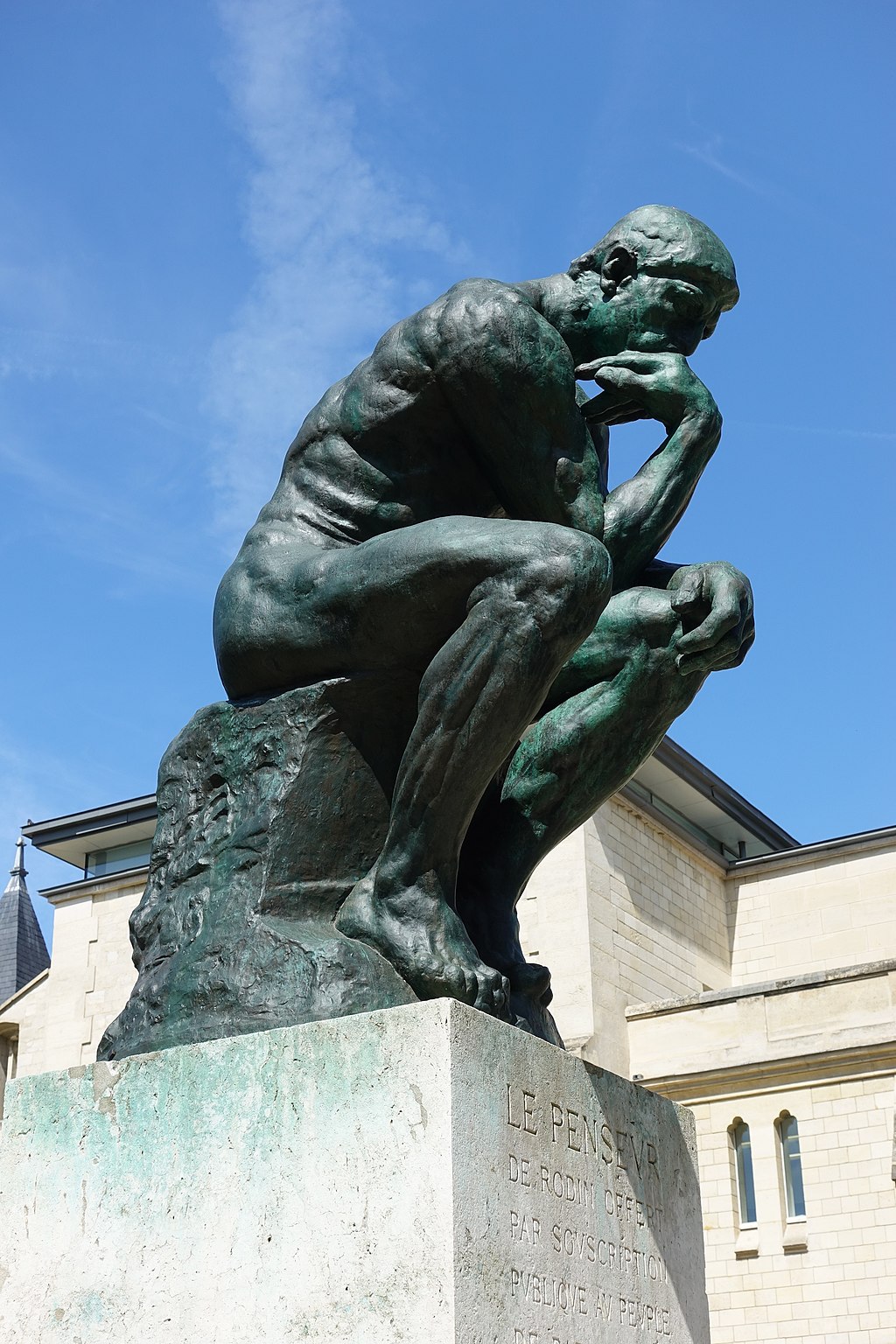
“I have a very strong intuition that what the majority of ‘scientists’ do science.”
“Was alchemy science?” … “Scientific terms must refer to the objective world.”
“Then the ‘scientists’ who theorized about phlogiston weren’t doing real science.”
“But we have no way of knowing if our theories now will end up like phlogiston…”
Etc.
Distinguishing science
Danger: relativism, skepticism, pseudoscience, amorality

Popper redescribed what science is with falsification theory.
- Influential: cleanly explained earlier partitions of ‘science’ from ‘non-science’.
- Took science to be a different thing, thereby changed what science was.
Kuhn redescribed what Popper (and previous users of the concept) were doing.
- Kuhn drew a distinction between revolutionary and ordinary science: He was able to draw the partition different from Popper while still seeing Popper’s verdict as precedential (Popper wasn’t just totally wrong; he was responding to science-as-redescribed-by-Kuhn but was confused without the helpful distinction).
Distinguishing science
Danger: relativism, skepticism, pseudoscience, amorality
We might presently take a stance on the history of science-like enterprises, e.g.:
- Alchemy (not science)
- Phlogiston (not science)
- Orbiting electron model (science)
- Nutrition (not science)
- Physics (science)
- Astrology (not science)
. . . We must give reasons, and not appropriately tying into previous uses of the term ‘science’ (as judged by future peers) means we fail to connect to the concept of “science” at all. We remain openminded to the possibility that future generations in their greater wisdom can make sense of what the field of nutrition was doing as tracking some independent norm.
When Evan fleshes out a “core logic of science”, he is making a rational reconstruction of the concept of science. This is a good and practical thing, as it will lead to a standard for legible science.
Normative character of intentionality in general
Danger: relativism, skepticism, pseudoscience, amorality
A mother lets me watch her kids and says to me: “Show the children a game.” When she returns, she sees me teaching them to gamble with dice. She angrily exclaims, “I didn’t mean that sort of game!” – Philosophical Investigations
- Map metaphor tempts us to find in the structure of the intent in the mother’s brain state at the time she issued the command
- if this isn’t possible, deny the mother was right
- Map metaphor tempts us to treat cognitive contents as part of some monotonic logic
- if this isn’t possible, deny the her rationality.
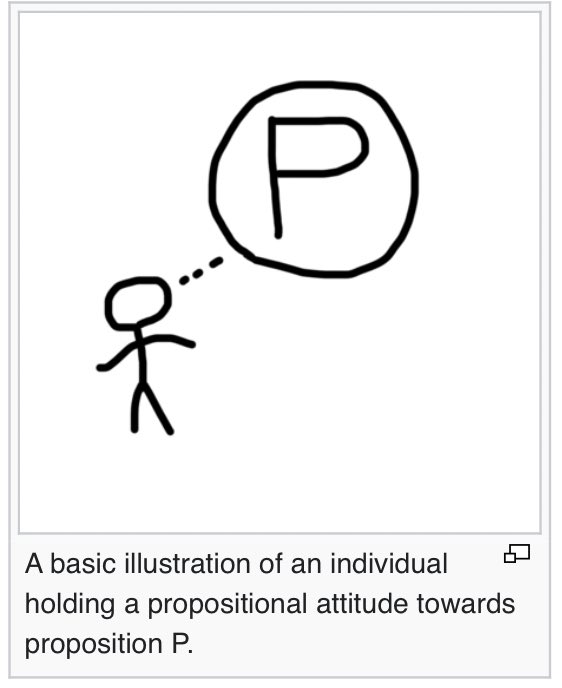
Likewise, we can make sense of Bertrand Russell asking if Plato’s discussion of “part” and “whole” was referring to the \(\epsilon\) or the \(\subset\) of set theory (or if Plato was conflating the two).
What someone is referring to depends both on us and on them.
Representation as a normative relation
Danger: relativism, skepticism, pseudoscience, amorality

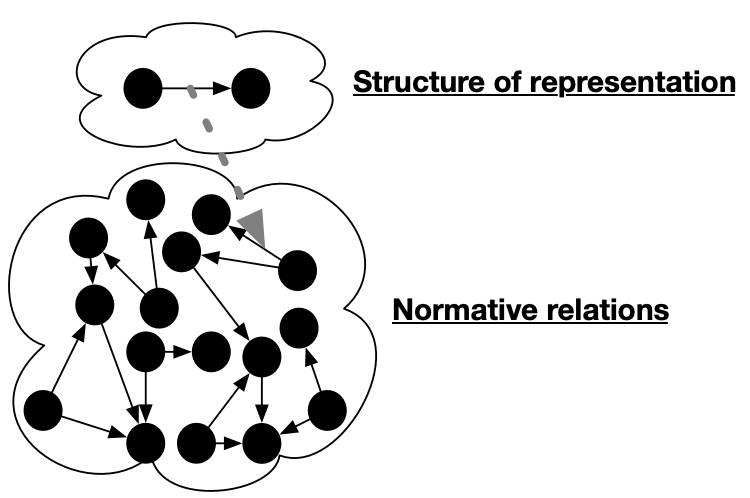
Representation itself can be thought of in terms of normativity. When \(A\) represents \(B\), it means that:
- \(A\) is responsible to \(B\)
- \(B\) has authority over the correctness of \(A\).

Conclusions
Danger: relativism, skepticism, pseudoscience, amorality
Revolutionary math and science (and politics)
- Requires a capacity to recognize how things which appear objective are in fact subjective.
- This is the kind of thing we want to do at Topos.
Normative character of definitions:
- By tying our definitions to concepts which have an inferential role in our language practices, they have an intrinsic normative character.
Inferentialist semantics rather than representational semantics:
- Unpacking meaning in terms of rational reconstructions of a tradition of its use (meaning of a word coming from its role in this practice, rather than its referent) is in line with the structuralist ethos of category theory.
- It likewise has a built-in distrust of semantic-web-esque ambitions in its explicit openness to future revision.
Conclusions
Danger: relativism, skepticism, pseudoscience, amorality
Common law metaphor for conceptual content
- Objective when viewed retrospectively, but also historically and socially-determined.
- Not relativism: rational reconstruction must frame the past as progressively moving towards some perspective-independent ideal.
- Not arbitrary: our rational reconstructions are at risk of being ruled non-precedential if we aren’t appropriately responsive to the ideals of the future ‘judges’.
- Yet these judges aren’t arbitrary either - they can only appeal to our usage.
- It foregrounds a mechanism by which we can change institutions: by getting other fields to redescribe their own intellectual history
- e.g. “They were doing category theory all along, even if they did not know it.”
Map metaphor seduces us to seek the right definitions rather than stay flexible.
More reading
Danger: relativism, skepticism, pseudoscience, amorality
- Main source:
- Related commentary of mine:
